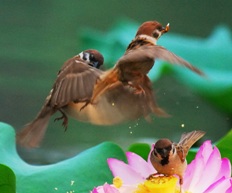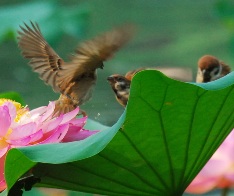 Listen to Shirley Singing the Poem in Chinese Sep 10,2012
Listen to Shirley Singing the Poem in Chinese Sep 10,2012 Listen to Shirley Singing the Poem in English Sep 10,2012
Listen to Shirley Singing the Poem in English Sep 10,2012 Listen to Shirley Singing the Poem in Chinese & English Aug 6, 2012
Listen to Shirley Singing the Poem in Chinese & English Aug 6, 2012 Listen to Shirley Introducing This Poem August 4, 2012
Listen to Shirley Introducing This Poem August 4, 2012 Follow Shirley to Read the Poem & Chinese Characters August 4, 2012
Follow Shirley to Read the Poem & Chinese Characters August 4, 2012  Learn the Meaning of the Poem With Shirley Together
Learn the Meaning of the Poem With Shirley Together See Shirley Created Picture & Calligraphy for the Poem Sep 23, 2012
See Shirley Created Picture & Calligraphy for the Poem Sep 23, 2012 See Shirley Created Picture & Calligraphy for the Poem April 23, 2012
See Shirley Created Picture & Calligraphy for the Poem April 23, 2012 See Shirley Created Picture & Calligraphy for the Poem August 12, 2011
See Shirley Created Picture & Calligraphy for the Poem August 12, 2011
Chun Xiao -- A Spring Morning is a very simple but quite famous Chinese classical poem by a Tang Dynasty poet Meng Haoran. In just 4 lines and 20 Chinese characters, it describes a very vivid and fresh glimpse of life.
The first two lines:
春眠不觉晓,
处处闻啼鸟 Chūn mián bù jué xiǎo, chùchù wén tíniǎo - Sleeping on a spring night, I've missed the dawn. Everywhere I hear the songs of birds.
The last two lines:
夜来风雨声,
花落知多少Yèlái fēngyǔ shēng, huāluò zhī duōshǎo - In the last night’s wind and rain, how many flowers have fallen?
As we read this poem, it feels like we can hear the singing of the birds, feel the fresh air in the morning and smell the sweet fragrance of the flowers and so that we naturally imagine the activities of the poet in our minds.
So, how can a little poem like this create such a good artistic effect?
Maybe because it captures the sounds of spring, touches our minds and guides our imagination.
When the poet opened his eyes on the spring morning, the first thing he heard was the singing of birds everywhere, he then thought of the sounds of the spring rains and the wind during the night and so he wanted to know how many flowers had fallen by the morning.
Catching the split second as he woke up, the poet wrote about the scenery of spring from an aural angle instead of describing it from a visual angle, he just wrote about what he heard from his room, instead of what he saw out of the door, and left plenty of room for the readers to imagine what a spring morning would be like. With the simplest language, he leads the readers into the boundless spring scenery.
Meng Haoran(689 - 740) was born in Xiangyang, in today’s Hubei province. Apart from spending a short time in the capital - Changan, to pursue his career, and traveling in Wu and Yue in today’s Jiangsu and Zhejiang, he lived in the Xiangyang area almost all his life.
Meng Haoran is as famous as Wang Wei, due to the friendship they shared and their prominence as idyll and landscape poets.
Meng Haoran succeeded Tao Yuanming (365—427), Xie Lingyun (385-433) and together with Wang Wei (701 - ), he was the ancestor of the Tang Dynasty’s Idyll and Landscape Poetry.
The language of his poems is very clean and simple, the feeling is kind and true, they are unique, free and full of the breath of life.
He, therefore, had a great reputation in Tang Dynasty. He was a good friend of Wang Wei, Li Bai, Wang Changling and Du Fu and he was admired by them all.
Together both of he and Wang Wei are known as “Wang and Meng” in the history of Chinese poetry.
With all these pleasant feelings, I created a piece of music to go with this little poem in 2005 and painted two paintings for to match its artistic conception after the study in China Central Academy of Fine Arts and in Chinese National Academy of Arts as my assignments 2011. I do hope my effort will be some help to you to learn Chinese language and culture.
Main Meaning of the PoemA Spring Morning
By Meng Haoran (Tang Dynasty)
Sleeping on a spring night, I've missed the dawn.
Eveywhere I heard the songs of birds.
In the night's wind and rain,
How many flowers have fallen?
Chinese Characters and Pronunciations You can click on any Chinese Character to open the New Character Board and see its Chinese pinyin, meaning, pronunciation and follow my reading, you can also click on the links to enter the Painting Column, to see more paintings and art notes that I wrote for the poem.
春晓 - Chūn Xiǎo
孟浩然 (689―740) - Mèng Hàorán(唐 - Tán?)
春眠不觉晓 - Chūn mián bù jué xiǎo,
处处闻啼鸟 - Chùchù wén tíniǎo。
夜来风雨声 - Yèlái fēngyǔ shēng,
花落知多少 - Huāluò zhī duōshǎo。
 If you have any questions, comments and suggestions, please write to shirley@ebridge.cn , or shirleyz004@yahoo.com, You are welcome.
If you have any questions, comments and suggestions, please write to shirley@ebridge.cn , or shirleyz004@yahoo.com, You are welcome.
Shirley Zhang
Written, Edited and Recorded Sep 11, 2012/ Auguest 4,2012/ April 29, 2012 / August 14, 2011/July 30, 2005
 Listen to Shirley Singing the Poem in Chinese Sep 10,2012
Listen to Shirley Singing the Poem in Chinese Sep 10,2012 Listen to Shirley Singing the Poem in English Sep 10,2012
Listen to Shirley Singing the Poem in English Sep 10,2012 Listen to Shirley Singing the Poem in Chinese & English Aug 6, 2012
Listen to Shirley Singing the Poem in Chinese & English Aug 6, 2012 Listen to Shirley Introducing This Poem August 4, 2012
Listen to Shirley Introducing This Poem August 4, 2012 Follow Shirley to Read the Poem & Chinese Characters August 4, 2012
Follow Shirley to Read the Poem & Chinese Characters August 4, 2012  Learn the Meaning of the Poem With Shirley Together
Learn the Meaning of the Poem With Shirley Together See Shirley Created Picture & Calligraphy for the Poem Sep 23, 2012
See Shirley Created Picture & Calligraphy for the Poem Sep 23, 2012 See Shirley Created Picture & Calligraphy for the Poem April 23, 2012
See Shirley Created Picture & Calligraphy for the Poem April 23, 2012 See Shirley Created Picture & Calligraphy for the Poem August 12, 2011
See Shirley Created Picture & Calligraphy for the Poem August 12, 2011 Chun Xiao -- A Spring Morning is a very simple but quite famous Chinese classical poem by a Tang Dynasty poet Meng Haoran. In just 4 lines and 20 Chinese characters, it describes a very vivid and fresh glimpse of life.
Chun Xiao -- A Spring Morning is a very simple but quite famous Chinese classical poem by a Tang Dynasty poet Meng Haoran. In just 4 lines and 20 Chinese characters, it describes a very vivid and fresh glimpse of life. If you have any questions, comments and suggestions, please write to shirley@ebridge.cn , or shirleyz004@yahoo.com, You are welcome.
If you have any questions, comments and suggestions, please write to shirley@ebridge.cn , or shirleyz004@yahoo.com, You are welcome.